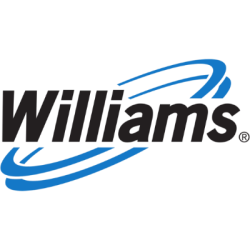Overall, Williams Companies demonstrates a strong business model with a solid competitive position and strategic focus on natural gas. Their future prospects are promising with a robust pipeline of projects and diversification into new markets, although they need to navigate regulatory challenges and market dynamics effectively.
Analysis Date: February 13, 2025
Last Updated: March 12, 2025
Trailing Twelve Months (TTM) values provide a view of the company's performance over the last year.
Graham Value Metrics
Benjamin Graham's value investing approach focuses on finding stocks with a significant margin of safety between their intrinsic value and market price.
Intrinsic Value
Estimated fair value based on Graham's formula
$70.26
Current Market Price: $54.64
IV/P Ratio: 1.29x (>1.0 indicates undervalued)
Margin of Safety
Gap between intrinsic value and market price
22.0%
Graham recommended a minimum of 20-30% margin of safety
Higher values indicate a greater potential discount to fair value
ROE: 17.940293091979278
ROA: 0.8912198342257757
Gross Profit Margin: 54.63772201860727
Net Profit Margin: 20.90968893900949
Trailing Twelve Months (TTM) values provide a view of the company's performance over the last year.
Strong Net Profit Margin
WMB's net profit margin of 20.91% indicates effective cost management and operational efficiency, translating to solid profitability.
Good Return on Equity
With a return on equity of 17.94%, WMB demonstrates a strong ability to generate returns for its shareholders, which is a positive sign for investors.
High Operating Cash Flow Valuation
19.01
EV/Operating Cash Flow
The EV/Operating Cash Flow ratio of 19.01 suggests that the stock may be overvalued relative to its operating cash flow, which raises concerns for potential investors.
About Profitability Metrics
Profitability metrics measure a company's ability to generate earnings relative to its revenue, operating costs, and other relevant metrics. Higher values generally indicate better performance.
Return on Equity (ROE)
Measures how efficiently a company uses its equity to generate profits
17.94%
10%
15%
Higher values indicate better returns for shareholders
TTM (as of 2025-04-16)
Return on Assets (ROA)
Measures how efficiently a company uses its assets to generate profits
0.89%
3%
7%
Higher values indicate better asset utilization
TTM (as of 2025-04-16)
Gross Profit Margin
Percentage of revenue retained after accounting for cost of goods sold
54.64%
20%
40%
Higher values indicate better efficiency in production
TTM (as of 2025-04-16)
Net Profit Margin
Percentage of revenue retained after accounting for all expenses
20.91%
8%
15%
Higher values indicate better overall profitability
TTM (as of 2025-04-16)
Interest Coverage Ratio
2.51
Interest Coverage Ratio
An interest coverage ratio of 2.51 indicates that WMB generates sufficient earnings to cover its interest expenses, showcasing financial stability.
High Debt Levels
2.17
Debt-to-Equity Ratio
49.40%
Debt-to-Assets Ratio
With a debt-to-equity ratio of 2.17 and a debt-to-assets ratio of 49.40%, WMB is heavily leveraged, which poses risks in economic downturns.
Low Liquidity Ratios
Current ratio of 0.50 and quick ratio of 0.45 indicate potential liquidity issues, suggesting that WMB may struggle to meet short-term obligations.
About Financial Health Metrics
Financial health metrics assess a company's ability to meet its financial obligations and its overall financial stability.
Debt to Equity Ratio
Total debt divided by total equity
2.17x
1.0x
2.0x
Lower values indicate less financial leverage and risk
Less than 1.0 is conservative, 1.0-2.0 is moderate, >2.0 indicates high risk
Q4 2024
Current Ratio
Current assets divided by current liabilities
0.50x
1.0x
2.0x
Higher values indicate better short-term liquidity
Less than 1.0 is concerning, 1.0-2.0 is adequate, greater than 2.0 is good
Q4 2024


